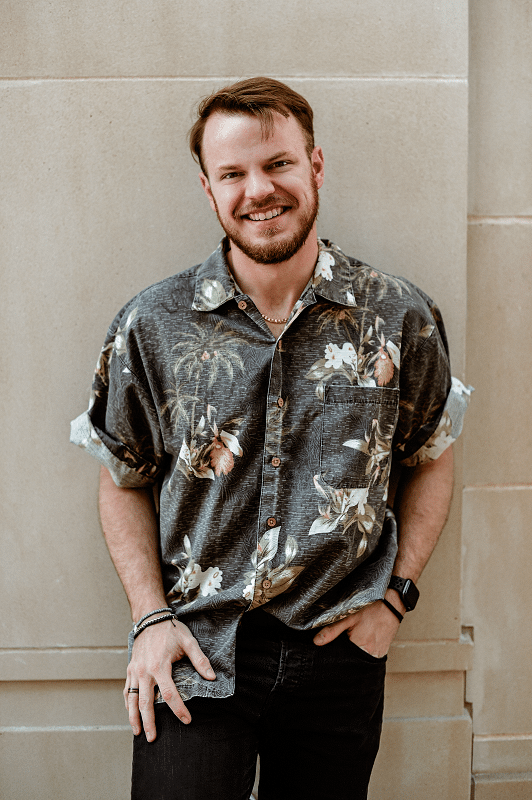SEAMLESS
Technology transforms the very concept of building services
Payton Lenz
Head of Digital Experience,
Ledger, Bentonville
DID YOU KNOW that Bentonville, Arkansas, is the Mountain Biking Capital of the World? You didn’t? Well, it is, and here’s the proof: That title has been trademarked by the Greater Bentonville Area Chamber of Commerce. Thanks in large part to backing from the Walton family, we have 130 miles of single-track connected to some 250 miles of amazing regional trails. “The mountain bike trails of Bentonville organically weave the outdoors into our everyday lives,” said then-Chamber president and CEO Graham Cobb when the trademarking took place back in 2020. “Top economic talent flocks here, so they can ride world-class, purpose-built single-track from their front porch to their office door. We’ve redefined rush-hour.”

It’s totally appropriate, then, that Bentonville is also home to the “World’s First Bikeable Building.” Called Ledger, it’s a six-story multi-use building backed by a group of local investors who were inspired by the indoor/outdoor culture in this community. We named the building Ledger because it balances the indoor and the outdoor aspects of life in this part of the state. The idea is to make this unique building, which we hope will open the first week of October, the “centerpiece of the community.” By that, we don’t mean to replace anything that’s already here; rather, we want to enhance, and collaborate with, the great cultural assets that have long made living here so desirable.
So, a bikeable building—what the heck does that mean, and how will it work? How it works will have a lot to do with me—more about that in a minute. But take a look at the photo of Ledger and the first thing you’ll notice are the ramps hair-pinning up and down the side of the building. You can literally ride your bike up to any of the six floors.
Once you go inside, there are mixed-use spaces throughout. Retail will be on the first floor. We’ll have a coffee shop and a café, of course, as well as several prestige retailers—for example, Mertin’s Eye Care and Specialized Bikes will both have their flagship stores here, and more are on the way. Additionally, the first floor will be home to 32 different types of bookable spaces, anything from individual media rooms up to 150-person classrooms. The second floor will be a co-working space with a few private offices and conference rooms, as well as some stadium seating and another little café area. There will also be a “hot desk” area where people can come and sit down at a free desk—or they can reserve one ahead of time. The third floor will be larger offices, spaces for 20 to 30 people, plus conference rooms and some hot desks sprinkled throughout. The fourth and fifth floors are currently being designed and custom built for our artists and our largest members. Finally, the sixth-floor rooftop will be one of our biggest showcases. We’ll have a huge private bar and patio area, along with rooms for any type of entertainment purposes—weddings, parties, what have you. From our rooftop, you can see Crystal Bridges and The Momentary. It’s an amazing view, especially in the evening as the sun sets over the Arkansas skyline.
The views inside the building will be nothing short of spectacular as well. We’ll have some 200 art pieces—works we’ve commissioned from local artists—on display throughout, a very purposeful amenity that visitors will notice and appreciate. And that brings me to my job, which is to create something much less obvious: the amenity of a seamless experience, some of which visitors will appreciate without even noticing that it’s happening.
*
I GREW UP in Missouri and studied engineering at Missouri University of Science and Technology in Rolla. After graduation, I went to Atlanta and worked at AT&T, where I helped build a very successful consulting practice around an area of famous technology. I was one of the first four staffers, and when I left, our little group had grown to over 90 people. I then applied to the “Life Works Here Talent Incentive Program” sponsored by the Northwest Arkansas Council—the goal of which is to get talented tech workers to move to the area. Of the tens of thousands of people who applied, I was one of the first 100 selected. Among the incentives I received were $10,000 and a mountain bike. Well, I thought, I guess I’m an
Arkansan now.
And what an opportunity it’s turned out to be. When I first got to Bentonville, I worked for Walmart, leading the development and deployment of Internet of Things (IoT) initiatives for the company’s U.S. Facilities Maintenance organization. When the job at Ledger presented itself, the technological possibilities were just too exciting to resist. I’ve only been here since April, and we’re still very much in the startup stage—there are only eight of us at the moment, which means we all wear a lot of hats. Ultimately, my responsibility will be everything technology, ranging from your normal internal IT suite to the IT experience for your members. It’ll be blended into the entire immersive experience of the building, so that if you reserve a conference room for 9 a.m. and you’re approaching the room, it will automatically unlock—because it knows that it’s you. When you pull up to the parking garage, the gate will open because it knows your car’s license plate. I’ll be helping design and make things like that a reality. At Ledger, everybody’s a VIP, and we want you to feel totally welcome.
That’s the short overview. On a deeper level, we might create a hologram of someone speaking about the history of the area, or maybe talking about the design of the building. We can have it in the middle of a room or in a dedicated corner, like an art piece kind of thing. Another idea: Why can’t we make an app for Ledger that’s your community app? So if you pull it up, it would have the schedules of all the buses that are coming, the airline schedules, your mountain bike reservation, your hotel reservation, all the ways you can pay local restaurants. That piece of technology goes back to the theme of our being the community hub and integrating everyone’s local info all in one place. It’s ideas like that that we’re evaluating as we go forward.
I don’t know of anyone else in the country with a job like mine. I feel like I’m in a unique place with the freedom I have to realize the owners’ greatest ambitions. “Hey, Payton,” they say, “we hired you for technology, so bring this experience to us. Show us what it can do.” It’s so much fun! Recently, I was totally focused on researching parking garages, and I learned more about that subject than I ever thought I would in my entire life. Because we want our parking garage to be the same as the building—integrated, immersive. We’re going to be partnering with other people in the area, and when they have an event, we need to make sure our technology can adapt to their needs and restrictions: Okay, only invited guests can park here tonight—how do we use technology to manage that?
One thing I’m really looking forward to is applying the principles of the relatively new field of Internet of Behaviors (IoB) here at Ledger. We’re going to observe a lot of data on the behavior of people throughout the day, and I’ll be very curious to assess that data to make sure we’re giving our members the experience and amenities they really need to get the most out of their time here.
I first started talking with people about IoB in Atlanta back in 2018, and then I began applying those principles throughout the IoT projects I was doing at AT&T. It’s important to bring this whole concept of human behavior into technology, because you have to have people wanting to use it and use it properly for it to make sense. If it doesn’t make sense, it doesn’t matter how good the technology is, it’s not going to work.

